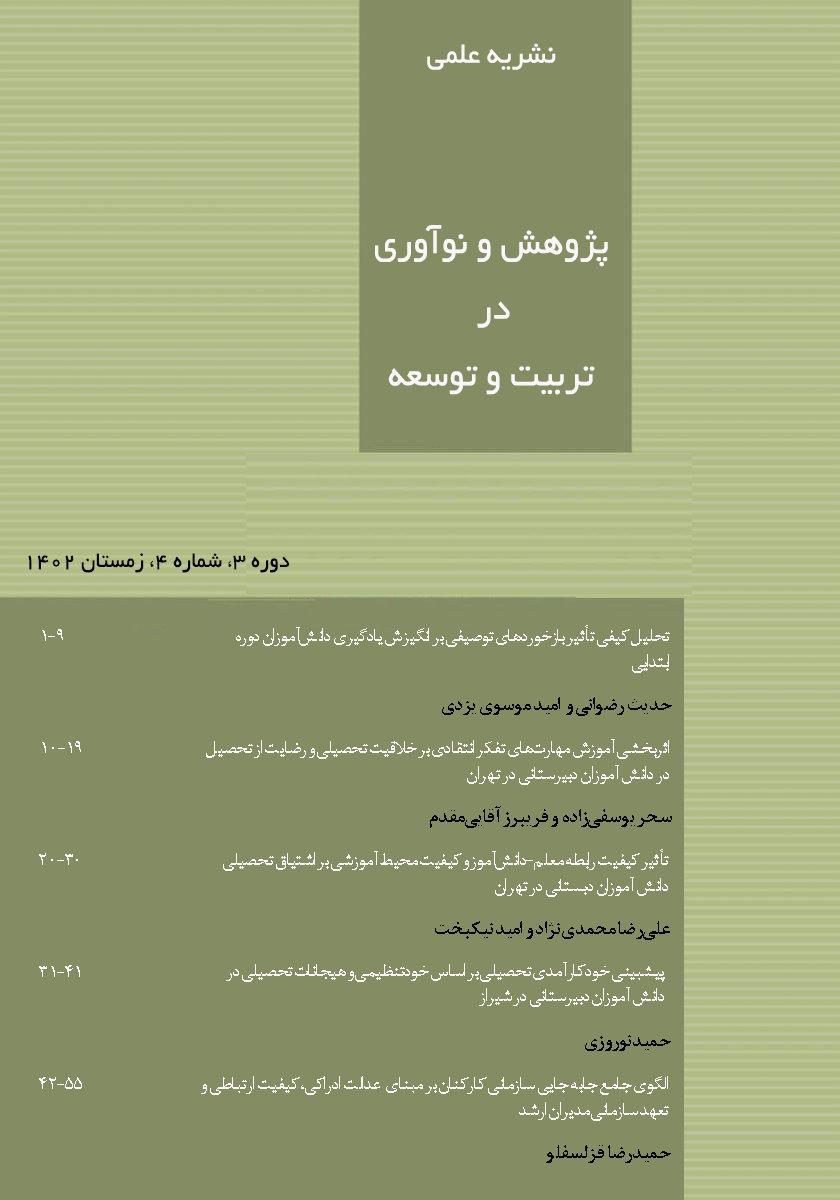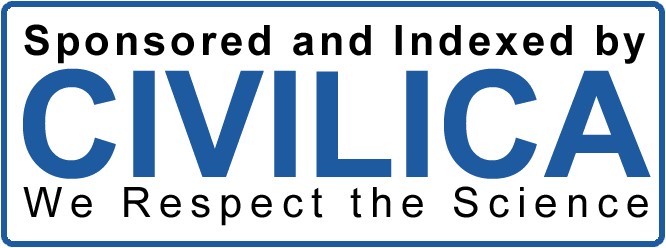Presenting a Structural Model of Factors Affecting Female Students' Adaptation to the School Environment and Comparing It with the Male Model
Keywords:
Structural Equation Modeling, School Environment Adaptation, Achievement Goals, SelfRegulation StrategiesAbstract
The present study aimed, on one hand, to propose a model of factors influencing students' adaptation to the school environment and, on the other hand, to compare this model between male and female students. The research method was correlational, and the statistical population consisted of all second-year high school students in Darab city. The research sample was selected using the Morgan Sampling Table and the proportional stratified sampling method. To measure students' adaptation to the school environment, Baker and Siryk’s (1989) School Adaptation Questionnaire, Miller and Brown’s (1999) Self-Regulation Strategies Scale, and Midgley et al.’s (1998) Goal Orientation Questionnaire were used. The data were analyzed using structural equation modeling and independent samples t-test. The results show that the direct effect of goal orientation (β = 0.372) and self-regulation strategies (β = 0.323) on female students' adaptation to the school environment was significant at the level of p = 0.01, and the direct effect of goal orientation on self-regulation strategies (β = 0.547) was statistically significant. The results of the independent samples t-test showed a significant difference between students' gender and the overall score of the School Adaptation Questionnaire (T = 2.203). Additionally, the mean adaptation score of female students to the school environment (M = 107.23) was significantly higher than that of male students (M = 96.14). Goal orientation and self-regulation strategies had a positive and significant impact on students' adaptation to the school environment. In the social adaptation component, male students demonstrated better social and interpersonal skills compared to female students, whereas female students exhibited better academic adaptation than males. Furthermore, in self-regulation strategy components such as acceptance and implementation, male students performed better than females, but in the planning component, females outperformed males.
Downloads
References
Abdollahi, R., & Rowli Zadeh Tabatabaei, K. (2013). The Impact of Computer Games on the Personality Characteristics and
Adjustment of Adolescents. Bi-Annual Journal of Women's Police Studies, 7(18), 106-184.
Ajam, A. A., Jafari Thani, H., Mehram, B., & Ahanchian, M. (2012). The Role of Self-Regulated Learning Strategies, Computer
Skills, and Academic Achievement in Students' Views Toward Synchronous and Asynchronous Interaction in Blended
Learning Approaches. Curriculum Planning Research, 9(34), 17-11.
Alagheband, A. (2002). Introduction to Educational Management. Ravan Publishing.
Ames, C. (1992). Classrooms: Goals, structures and student Motivation. Journal of Educational Psychology, 84, 261-271.
https://doi.org/10.1037/0022-0663.84.3.261
Ardalan, E., & Hossein Chari, M. (2010). Predicting Academic Adjustment Based on Communication Skills with the Mediation
of Self-Efficacy Beliefs. Educational Psychology Quarterly, 6(17), 28-21.
Atarodi, M., & Karshki, H. (2013). The Role of Perfectionism Dimensions and Goal Orientation in Predicting Students' SelfRegulation. Applied Psychology Research, 14(2), 109-101.
Bahrami, N., & Bahrami, Y. (2012). The Relationship Between Self-Regulation and Adjustment (Emotional, Social, and
Educational) Among Internet Users and Non-Users in Students.
Gonida, E. N., Voulala, K., & Kiosseoglou, G. (2009). Students' achievement goal orientations and their behavioral and
emotional engagement: Co-examining the role of perceived school goal structures and parent goals during adolescence.
Learning and Individual Differences, 19, 53-60. https://doi.org/10.1016/j.lindif.2008.04.002
Habibah, E., Nooreen, N., & Rahil, H. M. (2010). Achievement Motivation and Self-Efficacy in Relation to Adjustment among
University Students. Journal Of Social Sciences, 6(3), 333-339. https://doi.org/10.3844/jssp.2010.333.339
Haji Shamsaei, M., Karshki, M., & Amini Yazdi, S. A. (2013). The Role of Self-Regulation in Academic Adjustment of Male
and Female Students. Research in Educational Systems, 7(21), 17-11.
Hossein Chari, M., & Dehghani, Y. (2008). Predicting Academic Procrastination Based on Self-Regulated Learning Strategies.
Research in Educational Systems, 2(4), 75-63.
Jarvela, S., & Jarvenoja, H. (2011). Socially constructed self-regulated learning and motivation regulation in collaborative
learning groups. Teachers College Record, 113(2), 350-374. https://doi.org/10.1177/016146811111300205
Jokar, B. (2005). The Relationship Between Goal Orientation and Self-Regulation Among Students of Various Fields at Shiraz
University. Journal of Social Sciences and Humanities, Shiraz University, 22(4), 71-56.
Kadivar, P., Jowadi, M. J., & Sajadian, F. (2010). The Relationship Between Thinking Style, Self-Regulation, and Achievement
Motivation. Psychological Research, 2(6), 43-30.
Kajbaf, M. B., Moulavi, H., & Shirazi Tehrani, A. (2003). The Relationship Between Motivational Beliefs, Self-Regulated
Learning Strategies, and Academic Performance Among High School Students. Cognitive Science Updates, 5(1).
Kaplan, A., & Flum, H. (2010). Achievement goal orientations and identity formation styles. Educational Research Review,
(1), 50-67. https://doi.org/10.1016/j.edurev.2009.06.004
Karimi, R. (2002). A Study and Comparison of Academic Adjustment Levels in Male and Female Students in Physical Education
and Sports Sciences at Razi University [Master's Thesis, Razi University of Kermanshah.
Karshki, H. (2008). The Role of Achievement Goals in Components of Self-Regulated Learning. Cognitive Science Updates,
(3), 21-13.
Khadami, M., & Noshadi, N. (2006). The Relationship Between Goal Orientation, Self-Regulated Learning, and Academic
Achievement Among Pre-University Students in Shiraz. Journal of Social Sciences and Humanities, Shiraz University,
(4), 78-63.
Khodadadi, M. (2008). The Relationship Between Problem-Solving Skills and Adjustment Among First-Year High School
Students in Bashagard Region Islamic Azad University of Marvdasht].
Khormaei, F., Fasihani, S., & Azadi Dehbidi, F. (2018). Predicting Academic Adjustment Based on Learning Styles and
Academic Self-Regulation. Journal of Psychology Growth, 7(3), 111-128.
Kord, B., Pasha Sharifi, H., & Mirhashemi, M. (2013). The Role of Goal Orientation and Self-Regulation in Predicting Students'
Academic Performance. Iranian Journal of Medical Education, 13(10), 829-820.
Lubker, J. R. (2006). College adjustment experiences of first-year students: Retired athletes, non-athletes, and current varsity
athletes [Ph.D. Thesis, West Virginia University.
Mikaeili Mani, F. (2011). The Relationship Between Identity Styles, Identity Commitment, and Gender with Students'
University Adjustment. Psychological Studies Quarterly, 6(2), 74-51.
Mikaeili Mani, F., Fathi Gouna, S. M., & Zandi, K. (2015). An Analysis of the Relationships Between Hope, Self-Efficacy,
Motivation, and Stressors with Academic Adjustment Among Master's Students at Urmia University. New Educational
Thoughts Quarterly, 11(41), 78-57.
Rahbar Karbasdehi, F., Hossein Khan Zadeh, A. A., & Abolghasemi, A. (2018). The Effect of Self-Regulation Strategies on
Academic Self-Efficacy and Reading Performance in Dyslexic Students. Scientific-Research Quarterly of Family and
Research, 15(4), 49-66.
Rastegar, A. (2006). The Relationship Between Intelligence Beliefs and Academic Achievement With Mediating Role of
Achievement Goals and Academic Engagement University of Tehran].
Rezapur Mirsaleh, Y., Esmail Beigi Mahani, M., Fakarian Arani, S., & Khodaei, R. (2018). The Mediating Role of SelfRegulated Learning in the Relationship Between the Quality of Academic Consultation and Academic-Career Uncertainty
in High School Students. Scientific-Research Quarterly of Counseling Studies, 17(65), 30-47.
Robbins, S. B., Lauver, K., Le, H., Davis, D., Langley, R., & Carlstrom, A. (2004). Do psychological and study skill factors
predict college outcome? A meta-analysis. Psychological bulletin, 130, 261-288. https://doi.org/10.1037/0033-
130.2.261
Rostami, S., & Fouladchang, M. (2018). Examining the Causal Model of the Relationship Between Parental Emotional
Perspective and Academic Adjustment with the Mediation of Self-Differentiation. Educational Research Journal, 5(36),
-39.
Safavi, M., Mousavi Lotfi, M., & Lotfi, R. (2009). The Relationship Between Emotional Intelligence and Emotional and Social
Adjustment in Pre-University Female Students in Tehran. Journal of Research, Shahid Beheshti University of Medical
Sciences, 14(5), 261-255.
Samadi, M. (2004). Self-Regulated Learning in Students and Parents: A Study on the Role of Gender and Academic
Performance. Journal of Psychology and Educational Sciences, 34(1), 175-157.
Sanobar, A. (2018). The Relationship Between Happiness, Resilience, and Academic Self-Efficacy with Academic Adjustment
in Tenth Grade Boys. 1(8), 1-15.
Scheer, J. R., Clark, K. A., McConocha, E., Wang, K., & Pachankis, J. E. (2023). Toward Cognitive-Behavioral Therapy for
Sexual Minority Women: Voices From Stakeholders and Community Members. Cognitive and Behavioral Practice, 30(3),
-494. https://doi.org/10.1016/j.cbpra.2022.02.019
Schunk, D. H., Pintrich, P. R., & Meece, J. L. (2008). Motivation in education: theory, research, and applications (3rd ed.).
Pearson/Merrill Prentice Hall.
Sediqi Erfaei, F., Tamanaei Far, M., & Mansouri Nik, A. (2011). The Relationship Between Body Image, Adjustment, and
Academic Achievement in High School Students. Educational Innovations Quarterly, 9(38), 66-51.
Seif, A. A. (2013). Modern Educational Psychology: Learning and Teaching Psychology. Agah Publishing.
Talebi, S. (2008). The Relationship Between Academic Self-Efficacy and Academic Achievement with Emphasis on Behavioral,
Cognitive, and Motivational Engagement Among Students of Payame Noor University of Fars Province.
Vakili, R., Gholamali Lavasani, M., Hejazi, B., & Ejei, J. (2009). Learning Strategies, Goal Orientations, and Test Anxiety in
Blind Students. Research in the Field of Exceptional Children, 10(1).
Wolters, C. A. (2003). Regulation of motivation: Evaluating an underemphasized aspect of self-regulated learning. Educational
Psychologist, 38, 189-205. https://doi.org/10.1207/S15326985EP3804_1
Wolters, C. A. (2011). Regulation of motivation: Contextual and social aspects. Teachers College Record, 113(2), 265-283.
https://doi.org/10.1177/016146811111300202
YarMohammadian, A., & Sharafi Rad, H. (2011). An Analysis of the Relationship Between Emotional Intelligence and Social
Adjustment in Adolescents. Applied Sociology, 22(4), 50-34.
Zahed, A., Rajabi, S., & Omidi, M. (2012). Comparison of Social, Emotional, and Academic Adjustment and Self-Regulated
Learning in Students With and Without Learning Disabilities. Learning Disabilities Journal, 1(2), 62-43.
Zahmatkeshan, H. (2005). The Relationship Between Parenting Styles and Academic Adjustment and Achievement Among
Third-Year High School Students [Master's Thesis, Islamic Azad University, Arsanjan Branch.
Zarei, H., & Mirhashemi, M. (2012). The Relationship Between Thinking Styles and Academic Adjustment in Nursing
Students. Bimonthly Journal of Nursing and Midwifery, Urmia University, 10(3), 389-395.
Zhou, T. (2023). Design of University Integrated Education Management System Based on Blockchain Technology. 209-216.
https://doi.org/10.2991/978-94-6463-238-5_29
Zhu, H. (2023). Research on the Construction of University Education Informationization Leadership in WEB3.0 Era. Journal
of Education Humanities and Social Sciences, 22, 883-888. https://doi.org/10.54097/ehss.v22i.14557
Zimmerman, B. (2002). Becoming a self-regulated learner: An overview. Theory Into Practice, 41, 64-72.
https://doi.org/10.1207/s15430421tip4102_2
Zimmerman, B. J. (1990). Self-regulated learning and academic achievement: an overview. Educational Psychologist, 25(1),
Downloads
Published
Submitted
Revised
Accepted
Issue
Section
License
Copyright (c) 2024 Journal of Study and Innovation in Education and Development

This work is licensed under a Creative Commons Attribution-NonCommercial 4.0 International License.











